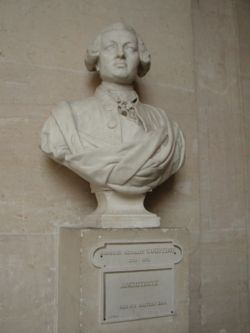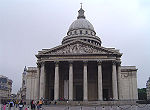
Jacques-Germain Soufflot
Encyclopedia


Architect
An architect is a person trained in the planning, design and oversight of the construction of buildings. To practice architecture means to offer or render services in connection with the design and construction of a building, or group of buildings and the space within the site surrounding the...
in the international circle that introduced Neoclassicism
Neoclassicism
Neoclassicism is the name given to Western movements in the decorative and visual arts, literature, theatre, music, and architecture that draw inspiration from the "classical" art and culture of Ancient Greece or Ancient Rome...
. His most famous work is the Panthéon, Paris
Panthéon, Paris
The Panthéon is a building in the Latin Quarter in Paris. It was originally built as a church dedicated to St. Genevieve and to house the reliquary châsse containing her relics but, after many changes, now functions as a secular mausoleum containing the remains of distinguished French citizens...
, built from 1755 onwards, originally as a church dedicated to Sainte Genevieve.
Biography
Soufflot was born in IrancyIrancy
Irancy is a commune in the Yonne department in Burgundy in north-central France. It is located southwest of Chablis in the northernmost part of Burgundy.-Irancy wines:...
, near Auxerre
Auxerre
Auxerre is a commune in the Bourgogne region in north-central France, between Paris and Dijon. It is the capital of the Yonne department.Auxerre's population today is about 45,000...
.
In the 1730s he attended the French Academy in Rome
French Academy in Rome
The French Academy in Rome is an Academy located in the Villa Medici, within the Villa Borghese, on the Pincio in Rome, Italy.-History:...
, where young French students in the 1750s would later produce the first full-blown generation of Neoclassical designers. Soufflot's models were less the picturesque Baroque
Baroque
The Baroque is a period and the style that used exaggerated motion and clear, easily interpreted detail to produce drama, tension, exuberance, and grandeur in sculpture, painting, literature, dance, and music...
being built in modern Rome, as much as the picturesque aspects of monuments of antiquity.
After returning to France, Soufflot practiced in Lyon
Lyon
Lyon , is a city in east-central France in the Rhône-Alpes region, situated between Paris and Marseille. Lyon is located at from Paris, from Marseille, from Geneva, from Turin, and from Barcelona. The residents of the city are called Lyonnais....
, where he built the Hotel-Dieu, like a chaste riverside street facade, interrupted by the central former chapel, its squared dome with illusionistic diminishing coffers on the interior. With the Temple du Change
Temple du Change
The Temple du Change or Loge du Change, formerly used for the stock exchange of Lyon, stands in Vieux Lyon . It was originally built after plans by architect Simon Gourdet between 1631 and 1653, then rebuilt under the direction of Jacques-Germain Soufflot in 1748-1750...
, he was entrusted with completely recasting a 16th century market exchange building housing a meeting space housed above a loggia. Soufflot's newly made loggia is an unusually severe arcading tightly bound between flat Doric
Doric order
The Doric order was one of the three orders or organizational systems of ancient Greek or classical architecture; the other two canonical orders were the Ionic and the Corinthian.-History:...
pilasters, with emphatic horizontal lines. He was accepted into the Lyon Academy.
A more creative trip to Italy was made when the mature Soufflot returned in 1750 in the company of the future Marquis de Marigny, the talented young brother of Madame de Pompadour
Madame de Pompadour
Jeanne Antoinette Poisson, Marquise de Pompadour, also known as Madame de Pompadour was a member of the French court, and was the official chief mistress of Louis XV from 1745 to her death.-Biography:...
, who was being groomed for his future as director of the King's buildings, the Bâtiments du Roi
Bâtiments du Roi
The Bâtiments du Roi was a division of Department of the household of the Kings of France in France under the Ancien Régime. It was responsible for building works at the King's residences in and around Paris.-History:...
. On this trip Soufflot made a special study of theaters. In 1755 Marigny, the new Director General of Royal Buildings, gave Soufflot architectural control of all the royal buildings in Paris. In the same year, he was admitted to the Royal Academy of Architecture. In 1756 his opera house
Opera house
An opera house is a theatre building used for opera performances that consists of a stage, an orchestra pit, audience seating, and backstage facilities for costumes and set building...
opened in Lyon.
The Panthéon is his most famous work, but the Hôtel Marigny built for his young patron (1768-1771) across from the Élysée Palace
Élysée Palace
The Élysée Palace is the official residence of the President of the French Republic, containing his office, and is where the Council of Ministers meets. It is located near the Champs-Élysées in Paris....
, is a better definition of Soufflot's personal taste. Soufflot died in Paris in 1780.
Like all the architects of his day, Soufflot considered the classical idiom essential. He stood out for his "strictness of line, firmness of form, simplicity of contour, and rigorously architectonic conception of detail" which contrasted sharply with the late Baroque and Rococo architecture of his contemporaries.

